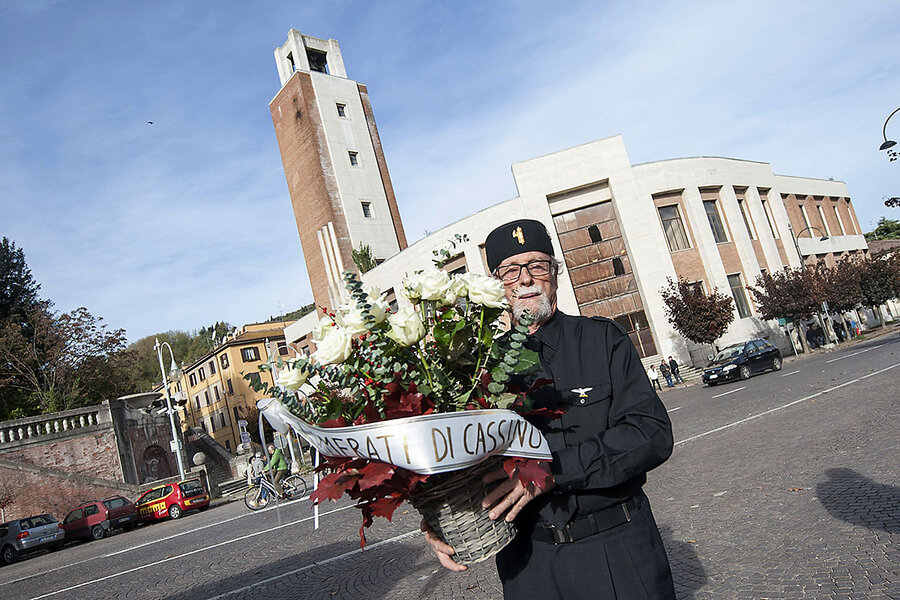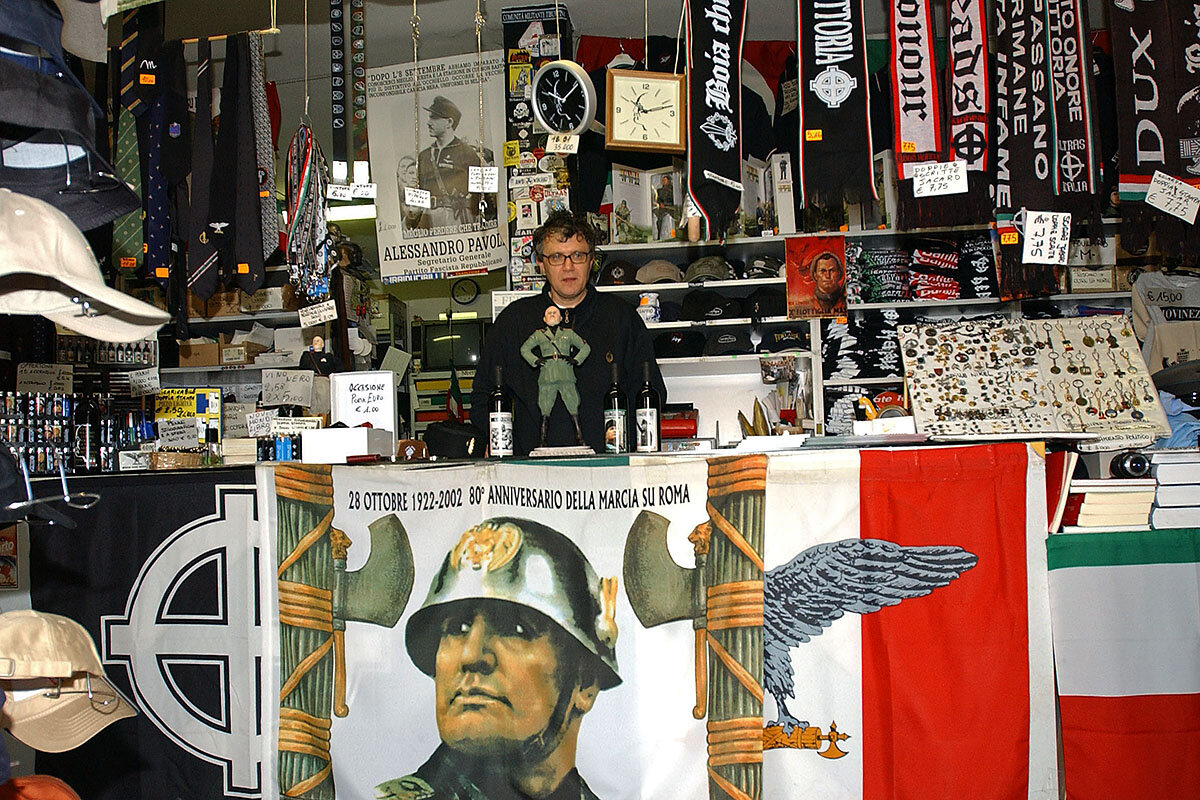As ban on 'Il Duce' trinkets looms, Mussolini's hometown eyes educational future
Loading...
| Predappio, Italy
The items on display are as varied as they are sinister – Mussolini busts, Mussolini keyrings, statues of “Il Duce” on a rearing stallion, and Mussolini propaganda posters. There are even Mussolini-themed babies’ bibs and pasta in the shape of Mussolini’s helmeted head.
The bizarre objects are crammed into a shop on the main street of Predappio, a town in northern Italy where Benito Mussolini was born in 1883.
In the past few decades it has become a place of pilgrimage for Italy’s unrepentant neo-Fascists: unabashed admirers of a man who led Italy into disastrous colonial adventures and an alliance with Adolf Hitler which brought Italy to its knees.
They descend on Predappio, in the Emilia-Romagna region, three times a year – on the anniversaries of Mussolini’s birth, death, and his March on Rome, the 1922 putsch which brought him to power. They gather at Mussolini’s resting place, a softly-lit stone tomb in an underground crypt on the outskirts of town, leaving tributes in a visitors’ book and admiring a collection of his personal possessions, including a pair of leather jackboots and a black shirt.
But the shops that sell Fascist memorabilia, as well as Nazi objects such as SS daggers, swastikas, and coffee cups bearing portraits of the Führer, may not be around very much longer.
A new law which outlaws the glorification of Fascism and Nazism and the selling of related souvenirs was passed by Italy’s lower house of parliament in September. This month it will be debated by the Senate, the upper house.
If approved, the shops that sell Mussolini posters, sweatshirts, and Zippo lighters will have to close down for good. And if the town mayor has his way, a tandem initiative will set Predappio on a new course, away from its dark past – by turning it into a home for academic study of Italy’s Fascist past.
“We want to change Predappio’s image and we also think that [the project] will be of value for the rest of Europe, a place to understand what happened during the 20th century,” says Giorgio Frassineti, the town mayor.
Telling Italians what really happened
Pier Luigi Pompignoli, the owner of one of the Mussolini shops, is open in his admiration for Il Duce. His business card proudly proclaims: “Duce, sei sempre nel mio cuore” – “you are always in my heart.” He claims that the Fascist dictator achieved many good things – including building new towns such as Predappio.
“Am I worried? Of course I am,” Mr. Pompignoli says. “But I’ve been selling these things for 35 years – how come the politicians have suddenly woken up now and said they should be banned?”
Predappio was constructed from scratch in the 1920s and 1930s around a crumbling stone farmhouse in which Mussolini was born.
The little town stands as an architectural paean to Italy’s two-decade Fascist era, an open-air museum of sleek modernist buildings grouped around an expansive central piazza.
One of the most imposing is called the Casa del Fascio and was built as a sort of rest and recuperation day center for Italians who visited the new town in the heyday of Fascist rule.
But Mayor Frassineti, from the center-left Democratic Party which governs Italy at the national level, wants to convert the building into a museum and a study center where scholars from around the world can debate the origins of 20th century totalitarianism.
He symbolizes the contradiction at the heart of Predappio – while the town attracts a hardcore of Fascist sympathizers from across Italy, most of its 6,000 inhabitants are far more liberal in outlook and have voted in center-left administrations for decades.
The battle over Predappio’s identity is reminiscent of the debate in the United States over Confederate statues and raises questions about how the past should be preserved and reinterpreted.
In Italy, one is never far away from reminders of the Fascist era – in Rome there is a towering stone obelisk that still bears the words “Mussolini Dux” and many other cities retain monuments erected in honor of Il Duce.
In Predappio, the mayor’s office is in Mussolini’s former bedroom in a 19th century town hall that was revamped on his orders in the 1920s.
The room is full of original furniture that was commissioned by Il Duce himself – including a chest of drawers in which the original fasces, the bundled rods that were a symbol of Fascism, were scratched off after the war by anti-Fascists.
“It’s fundamental to tell Italians what really happened – that Fascism was an enormous tragedy for us,” says Frassineti, a former high school teacher.
He would welcome the closure of the Fascist souvenir shops but thinks it is more important to “change people’s mentality” – to remind them that Fascism resulted in the extermination of Italian Jews in concentration camps and the catastrophe of Italy’s Axis alliance with Japan and Germany.
'History should not be hidden away'
Most local people appear to be behind him.
Sitting in a bar and reading the latest news about the proposed museum in a newspaper, Claudio Ceccaroni, a dentist, says, “I think it’s important to be able to tell future generations about this period of history and this museum will have exactly that role. Those who have left their mark on history should not be forgotten. History is history and should not be hidden away.”
Enrico Grilli, a retired army officer who served in a parachute regiment, says, “I think the idea of having a museum in the Casa del Fascio is a good one.
“Some say the Fascists committed crimes, but so did the Romans in the Colosseum. Does that mean we should demolish it and not consider Roman history?”
For now, the owners of the town’s Fascist emporia are watching and waiting to see whether the Senate passes the law.
In another shop on the main street, where Mussolini’s bull neck and jutting chin loom down from every shelf, the woman behind the counter was glum.
“We will do whatever the law tells us to do,” said the owner, who declined to give her name. “If they tell us to close, then we’ll have to close.”









